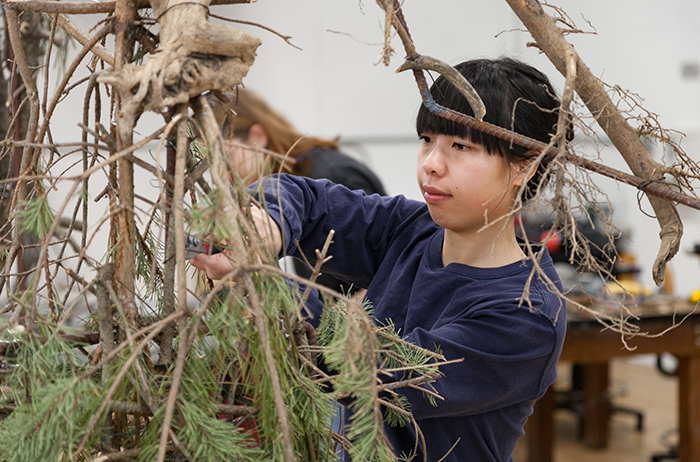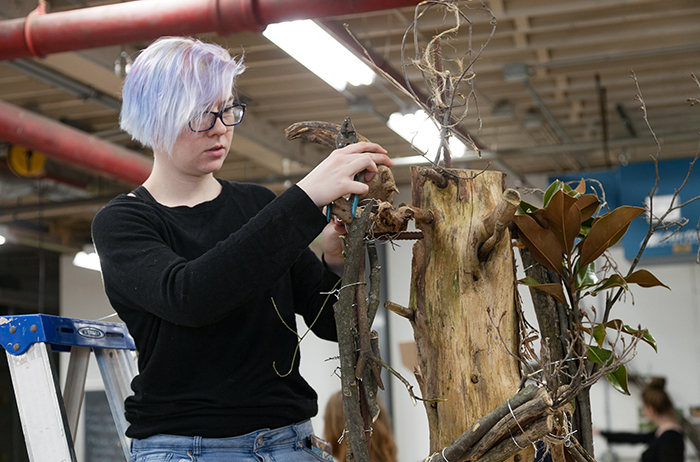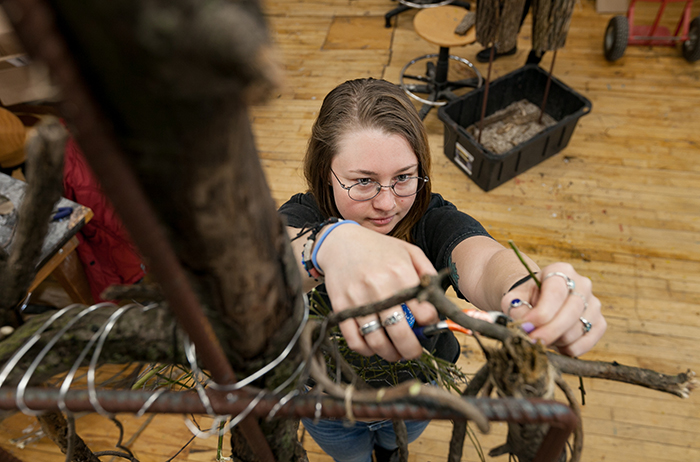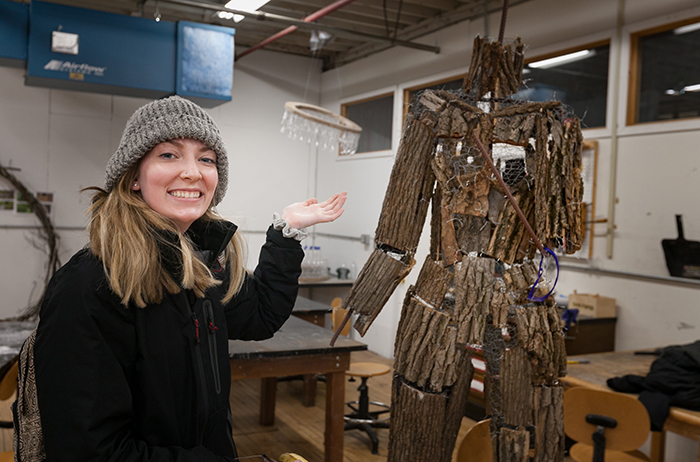Dickinson College Art and Sustainability Students Create Public Pieces to Be Viewed by Thousands

A student creates a sculpture out of natural materials for a juried outdoor exhibition. Photo by Carl Socolow '77.
Students exhibit sustainable artworks in open-air gallery
by MaryAlice Bitts-Jackson
Introductory-level art classes don’t usually include a public, juried show, but Associate Professor of Art Anthony Cervino’s Art and Sustainability class isn’t typical. Students enrolled in the class this spring—representing different class years and majors, and various levels of art-making experience—recently installed works in a local park that thousands of visitors will view over the weeks and months to come.
The works are part of the Art in the Wild exhibition, an annual, juried outdoor event held on a three-mile walking trail in Harrisburg’s 200-acre Wildwood Park. Cervino learned about the exhibition last summer and built his spring class around the opportunity (a past Art and Sustainability class created art from repurposed industrial material), spending several weeks on the basics before tasking them with proposing and creating works for public display.
The students divided into two groups—one created a joint abstract work, and the other created a figurative one. They scouted out locations at the park, discussed their project with park officials and, after zeroing in on a design, returned to Wildwood to collect natural materials. Then it was time to create.

Photo by Carl Socolow '77,
“You had to play with it and, to some extent, do what the material wanted you to do. And that took a lot of time outside of class,” says Erika Faulkner ’20 (political science, environmental studies), noting that at least two people were needed to bend and shape her group’s eight-foot circular form—a scheduling challenge.
“It was like: ‘This piece of wood looks interesting. How can I incorporate it into the work?' ” explains Katherine Manges ’19 (earth sciences).
Flooding, insects and wind … oh my!
The project, supported by a Center for Sustainability Education grant, provided an opportunity to engage with nature in new ways. The students also learned to use a variety of shop tools and to collaborate on a creative project, meeting several formidable practical challenges along the way.
Because the park is within a flooding zone and is home to many species of wildlife, they chose exhibition sites carefully (the abstract group opted to suspend its work over water, avoiding tampering by people and wildlife). The artworks also needed to be made of mostly natural materials and had to be able to withstand weathering and travel, since the students would construct the artwork on campus and then transport it to the park.

Photo by Carl Socolow '77.
“There was some engineering involved, and a lot of manual labor,” says Manges, who tightened wire supports on her work after shaking it vigorously to see if it would come apart in the wind, while teammate Clara Roth ’21 (art & art history, environmental science) used chicken wire to tame temperamental sheaths of bark.
Then installation time arrived. Olin Rhoads ’21 (mathematics, computer science) felt his waders fill up with mud as he edged out into the canal, along with Olivia Spildooren ’21 (environmental science).
“It was a lot deeper than we thought,” says Spildooren.
Olivia Greenleaf ’20 (undeclared) and her group used a stick and wire to suspend their abstract circle in the air. The challenge: to get the wire over a tree branch, high above their heads. “We figured out that we had to tie the wire around the heavier wire to weight it,” she notes.

Photo by Carl Socolow '77.
“In art, things don’t always go your way, so you have to problem-solve on the fly,” Faulkner says.
The big reveal
Their pieces installed, the students admired their work and attended an exhibition reception at the park.
“We were all working individually on different pieces of it, so we didn’t know for sure what it would look like,” Rhoads says. “Walking down the path and seeing it was amazing.”
“It was a magical experience,” Greenleaf adds.
Thousands of visitors are expected see their works, along with 13 other artworks on display on Wildwood Park’s main trail through October 31. The students also were featured on a news segment on WGAL-TV 8, a regional NBC affiliate.
TAKE THE NEXT STEPS
Published April 11, 2018